2014.5 Peugeot 308 fuel
[x] Cancel search: fuelPage 4 of 415
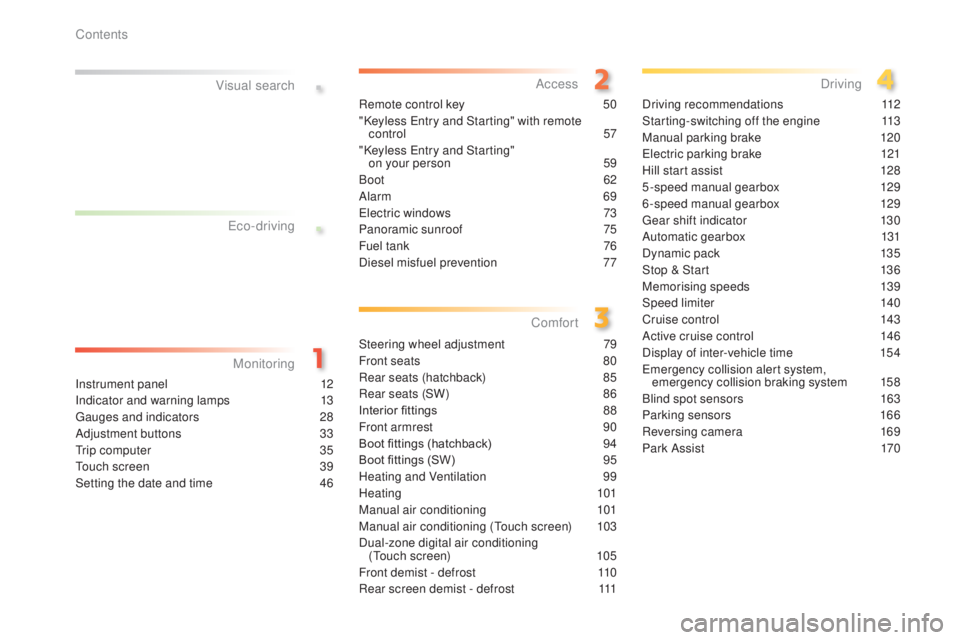
.
.
Visual search
Instrument panel 12
Indicator and warning lamps
1
3
ga
uges and indicators
2
8
Adjustment buttons
3
3
tr
ip computer
3
5
to
uch screen
3
9
Setting the date and time
4
6Remote control key
5
0
"Keyless e
n
try and Starting" with remote
control 57
"Keyless e
n
try and Starting"
on your person
5
9
Boot
6
2
Alarm
6
9
el
ectric windows
7
3
Panoramic sunroof
7
5
Fuel tank
7
6
Diesel misfuel prevention
7
7
Steering wheel adjustment
7
9
Front seats
8
0
Rear seats (hatchback) 8 5
Rear seats (SW) 8 6
Interior fittings
8
8
Front armrest
9
0
Boot fittings (hatchback)
9
4
Boot fittings (SW)
9
5
Heating and Ventilation
9
9
Heating
101
Manual air conditioning
1
01
Manual air conditioning (
to
uch screen)
1
03
Dual-zone digital air conditioning (
to
uch screen)
1
05
Front demist - defrost
1
10
Rear screen demist - defrost
1
11Driving recommendations
1
12
Starting-switching off the engine
1
13
Manual parking brake
1
20
el
ectric parking brake
1
21
Hill start assist
1
28
5-speed manual gearbox
1
29
6-speed manual gearbox
1
29
ge
ar shift indicator
1
30
Automatic gearbox
1
31
Dynamic pack
1
35
Stop & Start
1
36
Memorising speeds
1
39
Speed limiter
1
40
Cruise control
1
43
Active cruise control
1
46
Display of inter-vehicle time
1
54em
ergency collision alert system,
emergency collision braking system 1 58
Blind spot sensors 1 63
Parking sensors
1
66
Reversing camera
1
69
Park Assist
1
70
eco-driving
M onitoring Access
Comfort Driving
Contents
Page 5 of 415
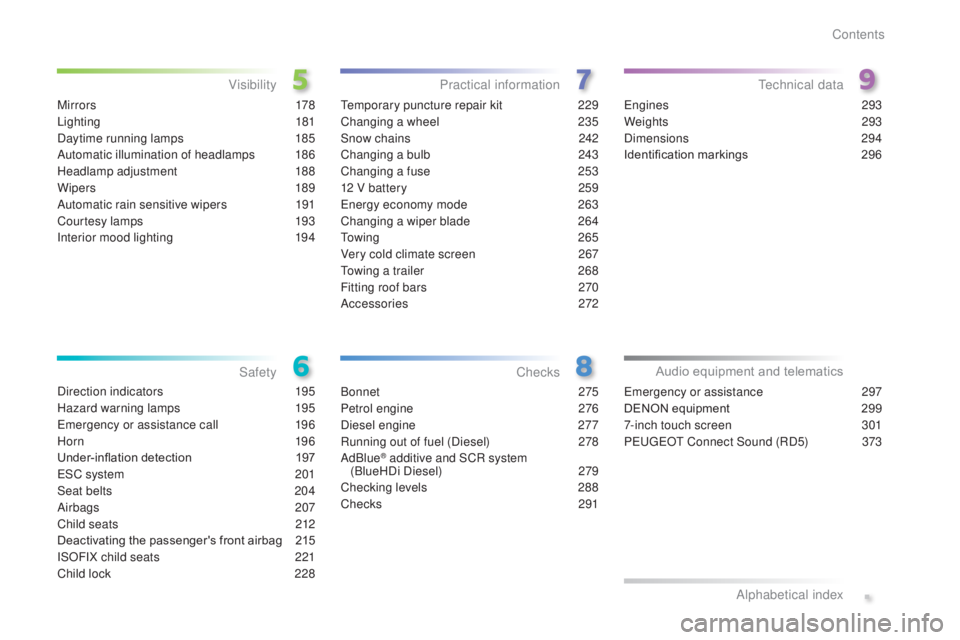
.
M i r r o r s 178
Lighting
181
Daytime running lamps
1
85
Automatic illumination of headlamps
1
86
Headlamp adjustment
1
88
Wipers
189
Automatic rain sensitive wipers
1
91
Courtesy lamps
1
93
Interior mood lighting
1
94te mporary puncture repair kit 2 29
Changing a wheel
2
35
Snow chains
2
42
Changing a bulb
2
43
Changing a fuse
2
53
12 V battery
2
59
en
ergy economy mode
26
3
Changing a wiper blade
2
64
to
w i n g
2 6 5
Very cold climate screen
2
67
to
wing a trailer
2
68
Fitting roof bars
2
70
Accessories
272
Bonnet
275
Petrol engine
2
76
Diesel engine
2
77
Running out of fuel (Diesel)
2
78
AdBlue
® additive and SCR system
(BlueHDi Diesel) 2 79
Checking levels
2
88
Checks
2
91
en
gines
293
Weights
2
93
Dimensions
2
94
Identification markings
2
96
Direction indicators
1
95
Hazard warning lamps
1
95
em
ergency or assistance call
1
96
Horn
19
6
Under-inflation detection 1
97
e
SC system
2
01
Seat belts
20
4
Airbags
207
Child seats
2
12
Deactivating the passenger's front airbag
2
15
ISOFIX child seats
2
21
Child lock
2
28
Visibility
Safety Practical information
Checkste chnical data
emergency or assistance 297
DENON equipment
2
99
7-inch touch screen
3
01
Peuge
O
t Connect Sound (RD5)
3
73
Audio equipment and telematics
Alphabetical index
Contents
Page 6 of 415
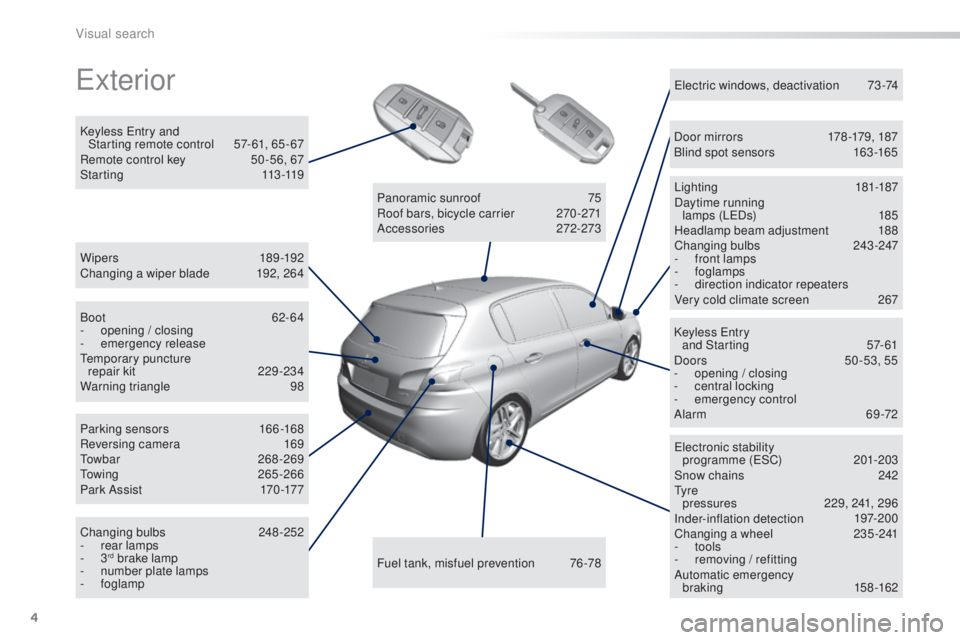
4
exterior
W ip e r s 18 9 -19 2
Changing a wiper blade 1 92, 264
Keyless
e
n
try and
Starting remote control
5
7- 61, 65 - 67
Remote control key
5
0 -56, 67
S t a r t i n g
113 -11 9
ele
ctronic stability
programme (
e
SC)
2
01-203
Snow chains
2
42
ty
r e
pressures
2
29, 241, 296
Inder-inflation detection
1
97-200
Changing a wheel
2
35-241
-
tools
-
r
emoving / refitting
Automatic emergency braking
158-162
Lighting
181-187
Daytime running lamps (L
eD
s)
1
85
Headlamp beam adjustment
1
88
Changing bulbs 2 43-247
- f ront lamps
-
foglamps
-
d
irection indicator repeaters
Very cold climate screen
2
67
el
ectric windows, deactivation
7
3-74
Keyless e
n
try
and Starting
5
7-61
Doors
50
-53, 55
-
ope
ning / closing
-
c
entral locking
-
em
ergency control
Alarm
69-72
Fuel tank, misfuel prevention
7
6-78
Panoramic sunroof
7
5
Roof bars, bicycle carrier
2
70 -271
Accessories
2
72-273
Boot
62-64
-
ope
ning / closing
-
em
ergency release
te
mporary puncture
repair kit
2
29-234
Warning triangle
9
8
Parking sensors
1
66-168
Reversing camera
1
69
to
wbar
268-269
to
wing
265-266
Pa r k A s s i s t
17
0 -17 7
Changing bulbs
2
48-252
-
r
ear lamps
-
3
rd brake lamp
-
n
umber plate lamps
-
foglamp Door mirrors
1
78 -179, 187
Blind spot sensors
1
63 -165
Visual search
Page 11 of 415
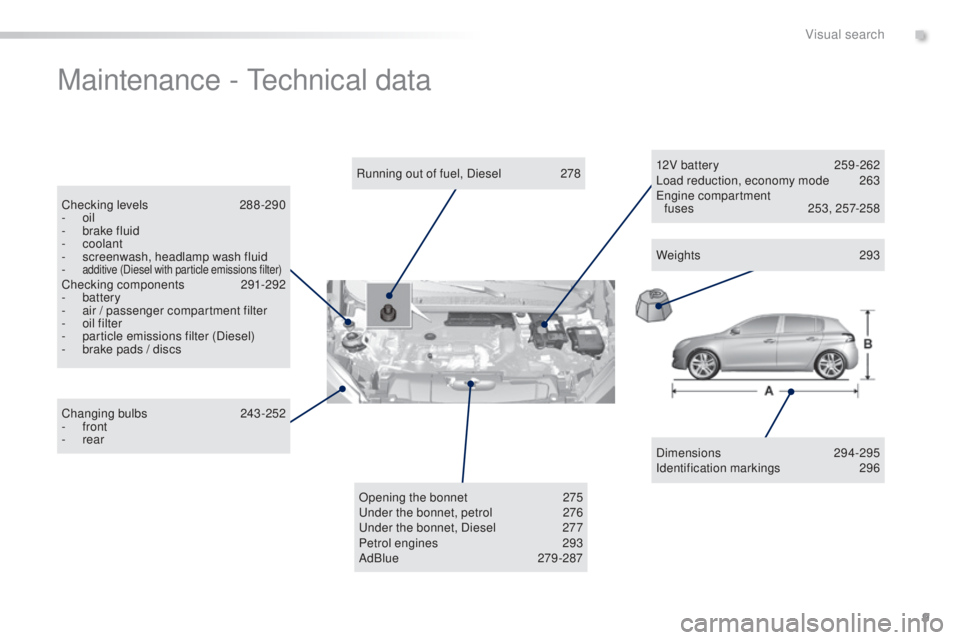
9
Maintenance - technical data
Dimensions 294-295
Identification markings 2 96
Running out of fuel, Diesel
2
78
Checking levels
2
88 -290
-
oil
-
b
rake fluid
-
coolant
-
s
creenwash, headlamp wash fluid
-
additive (Diesel with particle emissions filter)Checking components 2
91-292
- battery
-
a
ir / passenger compartment filter
-
o
il filter
-
p
article emissions filter (Diesel)
-
b
rake pads / discs
Changing bulbs
2
43-252
-
front
-
rear 12V battery
2
59 -262
Load reduction, economy mode
26
3
en
gine compartment
fuses
25
3, 257-258
Opening the bonnet
2
75
un
der the bonnet, petrol
2
76
un
der the bonnet, Diesel
2
77
Petrol engines
2
93
AdBlue
279 -287Weights
293
.
Visual search
Page 12 of 415
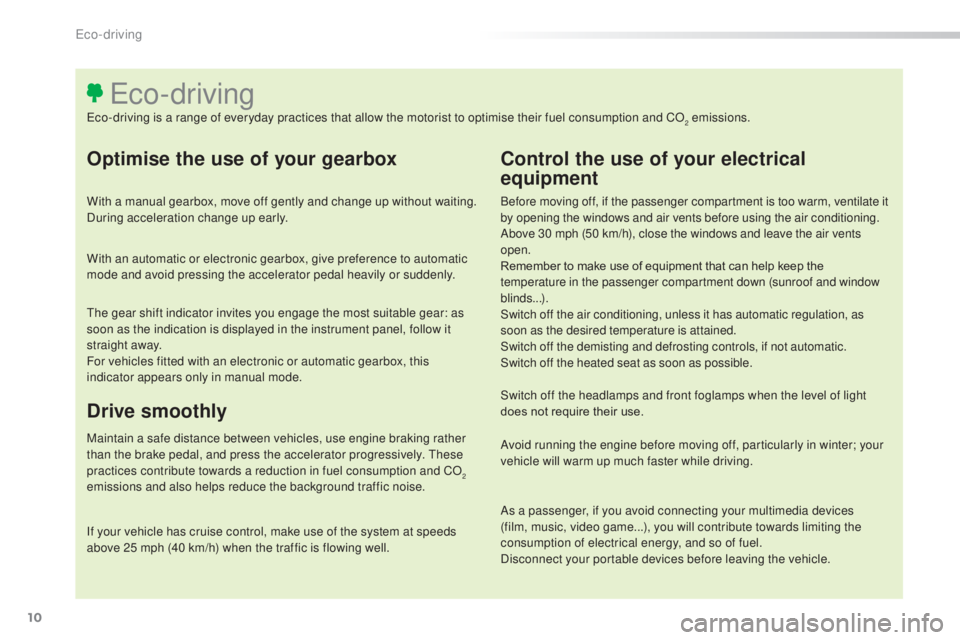
10
Optimise the use of your gearbox
With a manual gearbox, move off gently and change up without waiting.
During acceleration change up early.
With an automatic or electronic gearbox, give preference to automatic
mode and avoid pressing the accelerator pedal heavily or suddenly.
Control the use of your electrical
equipment
Before moving off, if the passenger compartment is too warm, ventilate it
by opening the windows and air vents before using the air conditioning.
Above 30 mph (50 km/h), close the windows and leave the air vents
open.
Remember to make use of equipment that can help keep the
temperature in the passenger compartment down (sunroof and window
blinds...).
Switch off the air conditioning, unless it has automatic regulation, as
soon as the desired temperature is attained.
Switch off the demisting and defrosting controls, if not automatic.
Switch off the heated seat as soon as possible.
Switch off the headlamps and front foglamps when the level of light
does not require their use.
Avoid running the engine before moving off, particularly in winter; your
vehicle will warm up much faster while driving.
As a passenger, if you avoid connecting your multimedia devices
(film, music, video game...), you will contribute towards limiting the
consumption of electrical energy, and so of fuel.
Disconnect your portable devices before leaving the vehicle.
eco-driving
eco-driving is a range of everyday practices that allow the motorist to optimise their fuel consumption and CO2 emissions.
Drive smoothly
Maintain a safe distance between vehicles, use engine braking rather
than the brake pedal, and press the accelerator progressively. th ese
practices contribute towards a reduction in fuel consumption and CO
2
emissions and also helps reduce the background traffic noise.
If your vehicle has cruise control, make use of the system at speeds
above 25 mph (40 km/h) when the traffic is flowing well.
th
e gear shift indicator invites you engage the most suitable gear: as
soon as the indication is displayed in the instrument panel, follow it
straight away.
For vehicles fitted with an electronic or automatic gearbox, this
indicator appears only in manual mode.
Eco-driving
Page 13 of 415
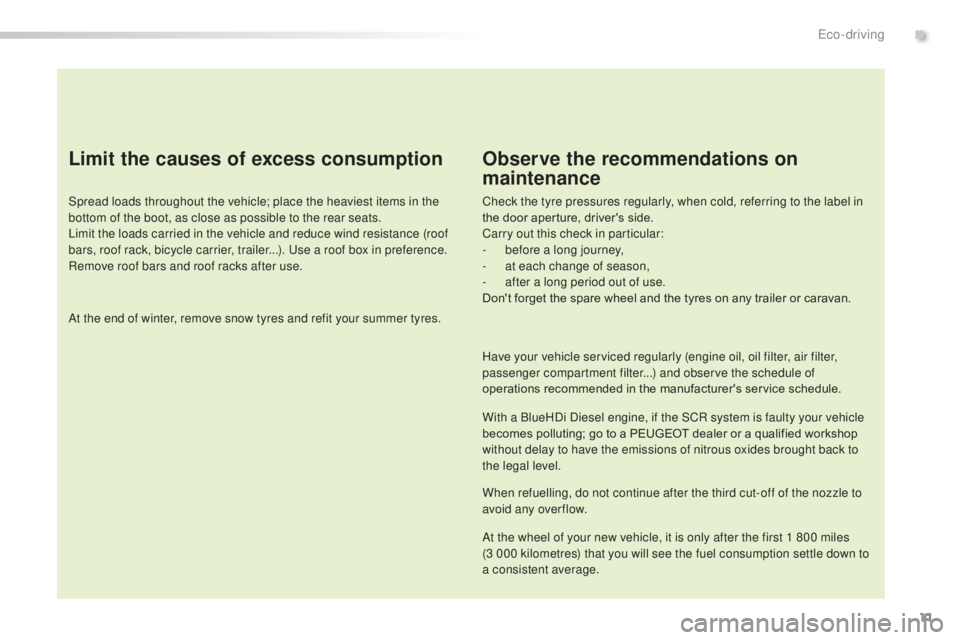
11
Limit the causes of excess consumption
Spread loads throughout the vehicle; place the heaviest items in the
bottom of the boot, as close as possible to the rear seats.
Limit the loads carried in the vehicle and reduce wind resistance (roof
bars, roof rack, bicycle carrier, trailer...). u
s
e a roof box in preference.
Remove roof bars and roof racks after use.
At the end of winter, remove snow tyres and refit your summer tyres.
Observe the recommendations on
maintenance
Check the tyre pressures regularly, when cold, referring to the label in
the door aperture, driver's side.
Carry out this check in particular:
-
b
efore a long journey,
-
a
t each change of season,
-
a
fter a long period out of use.
Don't forget the spare wheel and the tyres on any trailer or caravan.
Have your vehicle serviced regularly (engine oil, oil filter, air filter,
passenger compartment filter...) and observe the schedule of
operations recommended in the manufacturer's service schedule.
With a BlueHDi Diesel engine, if the SCR system is faulty your vehicle
becomes polluting; go to a PEUGEOT dealer or a qualified workshop
without delay to have the emissions of nitrous oxides brought back to
the legal level.
When refuelling, do not continue after the third cut-off of the nozzle to
avoid any over flow.
At the wheel of your new vehicle, it is only after the first 1 800 miles
(3 000 kilometres) that you will see the fuel consumption settle down to
a consistent average.
.
Eco-driving
Page 14 of 415
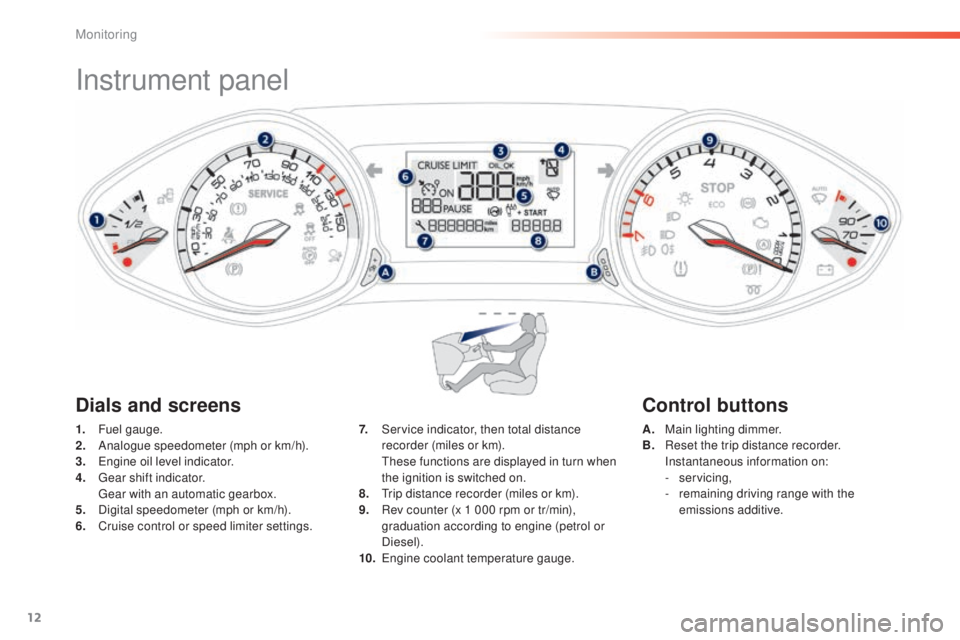
12
Instrument panel
1. Fuel gauge.
2. Analogue speedometer (mph or km/h).
3.
e
n
gine oil level indicator.
4.
g
e
ar shift indicator.
g
e
ar with an automatic gearbox.
5.
D
igital speedometer (mph or km/h).
6.
C
ruise control or speed limiter settings. A. M
ain lighting dimmer.
B. R eset the trip distance recorder.
I
nstantaneous information on:
-
servicing,
-
r
emaining driving range with the
emissions additive.
7. S
ervice indicator, then total distance
recorder (miles or km).
t
h
ese functions are displayed in turn when
the ignition is switched on.
8.
t
r
ip distance recorder (miles or km).
9.
R
ev counter (x 1 000 rpm or tr/min),
graduation according to engine (petrol or
Diesel).
10.
e
ng
ine coolant temperature gauge.
Dials and screens Control buttons
Monitoring
Page 24 of 415
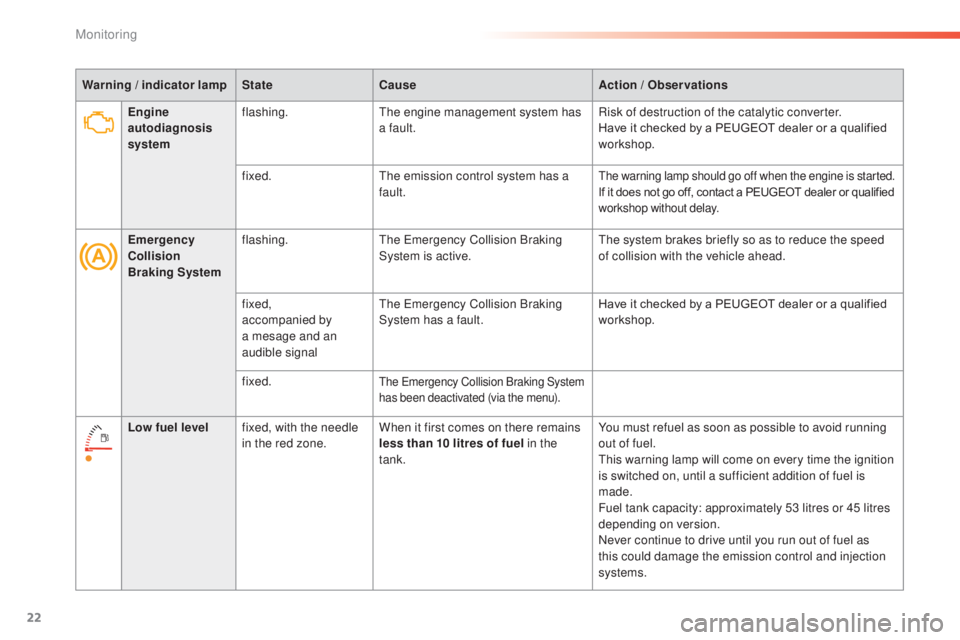
22
Engine
autodiagnosis
systemflashing.the
engine management system has
a fault. Risk of destruction of the catalytic converter.
Have it checked by a PEUGEOT dealer or a qualified
workshop.
fixed.
th
e emission control system has a
fault.
the warning lamp should go off when the engine is started.
If it does not go off, contact a PEUGEOT dealer or qualified
workshop without delay.
Emergency
Collision
Braking System flashing.the
em ergency Collision Braking
System is active.th e system brakes briefly so as to reduce the speed
of collision with the vehicle ahead.
fixed,
accompanied by
a mesage and an
audible signal
the
e
m
ergency Collision Braking
System has a fault. Have it checked by a PEUGEOT dealer or a qualified
workshop.
fixed.
the emergency Collision Braking System
has been deactivated (via the menu).
Warning / indicator lamp State Cause Action / Observations
Low fuel level fixed, with the needle
in the red zone. When it first comes on there remains
less than 10 litres of fuel
in the
tank. You must refuel as soon as possible to avoid running
out of fuel.
th
is warning lamp will come on every time the ignition
is switched on, until a sufficient addition of fuel is
made.
Fuel tank capacity: approximately 53 litres or 45 litres
depending on version.
Never continue to drive until you run out of fuel as
this could damage the emission control and injection
systems.
Monitoring